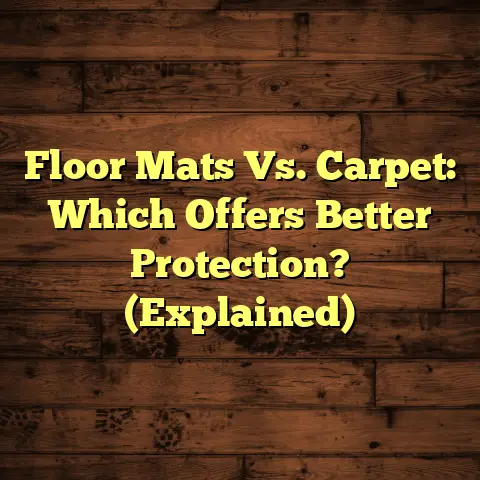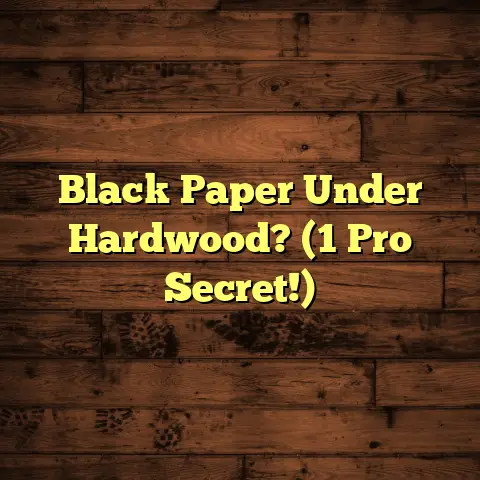How To Handle Scuff Marks On Laminate Wood Floors? (Explained)
I remember one afternoon when I received a call from a homeowner named Sarah, who had just installed stunning laminate wood floors in her living room. The sunlight streamed through the large windows, highlighting the rich, warm tones of the flooring. Sarah was thrilled about her new floors, but as we walked through the space, I noticed scuff marks marring the otherwise perfect finish. My heart sank for her because I knew how frustrating that could be for any homeowner.
Scuff marks can appear on laminate wood floors for various reasons: moving furniture, shoes dragging across the surface, or even pet claws. Today, I want to share my experiences, tips, and tricks on how to handle scuff marks effectively while maintaining the beauty of your laminate flooring.
Understanding Scuff Marks
Having dealt with scuff marks for years, I’ve come to understand that they are often a common occurrence in homes with laminate floors. They can result from various factors, including:
- Foot Traffic: Regular walking can leave marks, especially if people wear shoes with rubber soles.
- Furniture Movement: Moving furniture without proper protection can lead to scratches and scuffs.
- Pets: If you have pets, their claws can easily scratch and scuff the surface.
Tip: To prevent scuff marks from becoming a headache, it’s wise to take proactive measures in maintaining your floors.
Identifying the Scuff Marks
The first step in dealing with scuff marks is identifying what type you’re dealing with. Not all marks are created equal. Some may be surface dirt mixed with rubber from shoes, while others may be more stubborn and require a different approach.
Quick Test
A quick test I often recommend is to rub your finger over the scuff. If it comes off easily, it’s likely just dirt or rubber. If not, it may require a different method of cleaning. This simple test can save you time and effort as you decide on the best approach to tackle the issue.
Quick Fixes for Scuff Marks
When I first started in this business, I often relied on heavy-duty cleaners or commercial products that promised instant results. However, I quickly learned that many of these products could do more harm than good to laminate surfaces. Here are my go-to methods for quick fixes:
1. Soap and Water Solution
One of my first lines of defense is a simple mix of warm water and mild dish soap. It’s gentle on the laminate but effective at removing light scuff marks.
- How to Use: Grab a soft cloth, dampen it with the soap solution, and gently rub the scuff mark. Often, this method works wonders!
2. Baking Soda Paste
If the mark persists after using soap and water, my second option is baking soda. This pantry staple is a powerful cleaning agent.
- How to Use: Mix baking soda with a little water to form a paste. Apply it gently with a soft cloth and rub in circular motions over the scuff mark. Rinse with clean water afterward to avoid leaving any residue.
3. Magic Eraser
Magic erasers have become a staple in my cleaning arsenal. They’re fantastic for lifting scuff marks without damaging the finish of laminate floors.
- How to Use: Lightly dampen the magic eraser and gently rub over the scuff mark. Most times, it lifts off without much effort.
Dealing with Stubborn Scuff Marks
Some scuffs are more persistent than others and require a more robust approach. In my experience, here are some methods that have proven effective:
1. Vinegar Solution
Mixing equal parts vinegar and water creates a powerful cleaner for tougher marks.
- How to Use: Spray it onto the scuff and let it sit for a few minutes before wiping it away with a clean cloth. The acidity of the vinegar helps break down stubborn residues.
2. Commercial Cleaners
In some cases, laminate-specific cleaners designed to tackle tough stains can be effective.
- Tip: Always read labels and test in an inconspicuous area first to ensure it won’t damage your flooring.
3. Refinishing
If none of these solutions work, refinishing the affected area might be necessary. This process involves sanding down the top layer and applying a new finish.
- Note: Refinishing should be reserved for severe cases since it can be labor-intensive and requires some skill.
Prevention Tips
After spending countless hours dealing with scuff marks on laminate floors, I’ve learned that prevention is key. Here are some of my tried-and-true tips:
1. Use Furniture Pads
Placing felt pads under furniture legs can prevent scratches and scuffs when moving items around.
2. Regular Cleaning
Regularly sweeping or vacuuming helps prevent dirt buildup that could contribute to scuffs.
3. Area Rugs
Using area rugs in high-traffic areas protects your floors from wear and tear.
4. Shoe Policy
Encouraging family members and guests to remove their shoes before entering can significantly reduce scuffs.
5. Pet Grooming
If you have pets, regular nail trimming can prevent scratches from their claws.
Cost Estimation and FloorTally
As someone who has been in the flooring business for years, I understand how important accurate cost estimations are for clients. That’s where FloorTally has been incredibly helpful for me in my flooring tasks.
Accurate Estimates
FloorTally pulls local material and labor rates to provide precise estimates for projects. For instance, when I recently worked on a home renovation project involving laminate floors in a 1,200 sqft living room, using FloorTally allowed me to present an accurate budget right from the start.
This transparency built trust with my clients because they appreciated knowing exactly what they were getting into financially. Plus, with features that account for potential hidden costs such as removing old flooring or waste factors, I can offer clients a comprehensive view of what to expect.
Success Stories
I recall a project where I needed to replace old carpet with laminate flooring in a busy family home. FloorTally helped me estimate costs based on local rates for materials and labor accurately. The family was thrilled when they saw how closely my estimates matched the final bill! This not only made them happy but also established a solid reputation for me as a reliable contractor.
Learning from Experience
Throughout my career as a flooring contractor, I’ve encountered various challenges while dealing with scuff marks on laminate floors. There was that one time when I mistakenly used too harsh of a cleaner on a client’s new floor—it left streaks that took hours to fix!
On the flip side, I’ve also had great successes where simple techniques made all the difference. Sharing these experiences with clients helps them feel more confident about maintaining their floors.
Challenges Faced
One of the most significant challenges I’ve faced was on a project where I installed laminate flooring in a home with three young children and two dogs. Within days of installation, there were numerous scuff marks and scratches due to high traffic and playful activities. I promptly educated the family on maintenance tips and provided them with preventive measures like furniture pads and area rugs.
The Importance of Communication
Communicating effectively with clients about maintenance is crucial for ensuring their satisfaction long after the installation is complete. During consultations, I make it a point to discuss care instructions thoroughly.
Setting Expectations
When working with homeowners, I set realistic expectations about maintaining their laminate floors. This includes discussing potential wear and tear and how best to keep them looking fresh.
Follow-Up
I also make it a habit to follow up after completing a project to see how they’re managing their new flooring. This shows clients that I care about their experience and satisfaction beyond just the sale.
Comparative Analysis of Cleaning Products
Now that we’ve covered various methods for handling scuff marks let’s compare some cleaning products I’ve used over time:
| Product Type | Effectiveness | Cost | Pros | Cons |
|---|---|---|---|---|
| Soap & Water | Moderate | Low | Safe for all surfaces | May not remove stubborn marks |
| Baking Soda Paste | High | Low | Natural cleaner | Requires rinsing |
| Magic Eraser | High | Moderate | Easy to use | Can wear out quickly |
| Vinegar Solution | High | Low | Inexpensive & effective | Strong smell |
| Commercial Cleaners | Varies | Moderate-High | Specifically designed for laminate | May contain harsh chemicals |
In my experience, natural options like soap and water or vinegar solutions are excellent first attempts since they are gentle yet effective for light cleaning tasks. However, for tougher stains, magic erasers or commercial cleaners might be necessary.
Technical Specifications
When discussing cleaning products or techniques for laminate floors, it’s essential to consider certain technical specifications related to the materials involved:
Manufacturing Processes
Laminate flooring is composed of several layers:
- Wear Layer: A transparent layer that protects against scratches and stains.
- Design Layer: Features printed images that mimic wood or other materials.
- Core Layer: Made from high-density fiberboard (HDF) provides stability.
- Backing Layer: Offers moisture resistance and adds strength.
Understanding these layers helps when choosing cleaning products or methods since some may damage specific layers more than others.
Maintenance Guidelines
Most manufacturers recommend specific cleaning guidelines to prolong the life of your laminate flooring:
- Avoid Excessive Water: Too much water can seep into seams and cause damage.
- Use a Damp Mop: When mopping, use a damp mop rather than soaking wet.
- Avoid Abrasives: Steer clear of abrasive cleaners that could scratch or dull the finish.
Final Thoughts on Maintaining Laminate Floors
Handling scuff marks on laminate wood floors doesn’t have to be daunting. With the right techniques and preventive measures, you can keep your floors looking great for years to come.
By sharing my personal insights and experiences, I hope you feel equipped to tackle any scuffs that come your way. Remember, keeping your laminate floors pristine is all about preventing damage before it happens and knowing how to address issues if they arise.
If you have any other tips or tricks you’ve found useful in handling scuff marks on laminate floors, please share! After all, we’re all in this together in the world of flooring maintenance!





